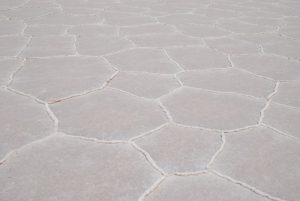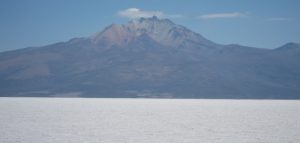We start the day learning how the people of Colchani harvest and package salt from the salt flats. They scrape salt loose by hand or machine. There are three grades of salt: construction salt which has lots of dirt in it, cooking salt which has a tad of dirt in it and souvenir salt which is the purest grade. The cooking salt is dried, has iodine added to it and packaged. Unfortunately the labour involved in this process exceeds the price obtained, so it is a difficult business. The souvenir salt is mixed with water and white glue and placed in molds to make various items for the tourist trade.
Driving across the salt flat, we stop to see where they harvest this salt
and also where they cut salt blocks, like bricks, to use in construction of
walls. The blocks are cut, dried and taken away by truck. The hole left is
eventually filled in when the rain water melts the salt and the slurry mixed with a little dirt creates a new layers over the next few seasons. So it is a perpetual business as long as there is a need for these salt blocks.
We drive further onto the center of the salt flat, and we see that there is
less and less dirt on the surface, and more whiteness. The hexagonal shapes
on the surface are intriguing and fascinating. Looking in each direction, there is just whiteness far off into the distance.
 The surface is flat in the center of the former inland sea but as we approach the edge and drive onto land again, the salt ground is rough and broken up just like ice on a lake does in the spring in Alberta. We hike to the top of Isla Incahuasi, in the middle of the flats and looking out over the expanse, the salt flats appear to be the top of a cloud when flying at 35,000 feet or a blanket of freshly fallen snow.
The surface is flat in the center of the former inland sea but as we approach the edge and drive onto land again, the salt ground is rough and broken up just like ice on a lake does in the spring in Alberta. We hike to the top of Isla Incahuasi, in the middle of the flats and looking out over the expanse, the salt flats appear to be the top of a cloud when flying at 35,000 feet or a blanket of freshly fallen snow.
We cross the salt flats and drive onto the base of a volcano called Tunupa’s. Liz tells this story. Tunupa was a young girl who fell in love with Cusco, a young man. They married and wereliving very happily, when another woman, Cosuna, came along and stole Cusco away. Tunupa cried and cried and the salt from her tears made the salt lake and the Gods felt sorry for her so they turned her into a volcano and made the land on her slopes very fertile, which is why that area is the only place where royal quinoa, is grown. Cusco and Cosuna were also turned into mountains, close to one another but never touching. Cusco was turned into a deserted mountainwhere nothing grows and Cosuna was turned into a mountain that is covered in snow and is the source of water for Uyuni.
The day is spent on and around Salar de Uyuni. It is an exceptional place with great vistas everywhere, on the flats, high on the island and on Tunupa’s slopes.




